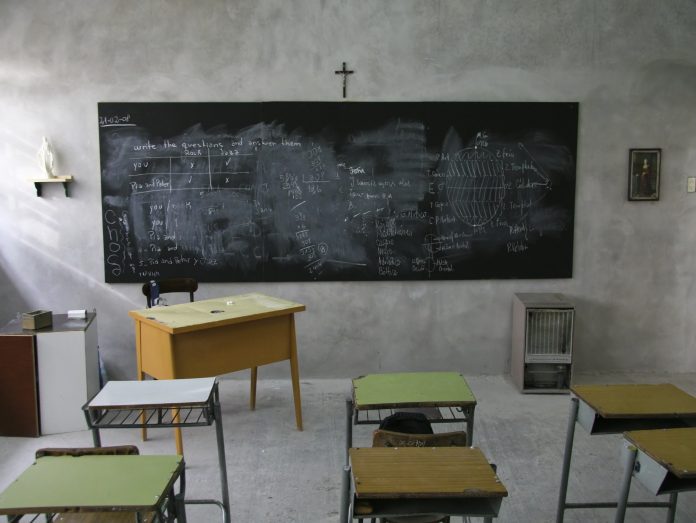
by Daniel Thomas
When I began my ministry as a director of religious education at Immaculate Conception Parish in Dayton, Ohio, my office was in the parish school building in a small room between the two second-grade classrooms. Much of my work those first years was with sacramental preparation, especially First Reconciliation and First Communion.
During the third year of working with Patti and Connie, we were talking informally and Connie said to me, “Dan, you know that, for you, DRE means ‘Dan Reads Everything.’” I was a little surprised by this at first, but as I reflected on that description, I realized the truth of the statement. For me, reading is a very important part of who I am and how I go about things.
Books and the media—and the way in which they help me learn about life from a perspective different from my own—have always been a part of my life. I have always been a reader going back to the days when the bookmobile from the public library came to our neighborhood. I usually took out the maximum number of books permitted, and waited impatiently for the next visit. Books were always a key part of how I handled my life. The way I quit smoking was to check out from the library a book about how to quit smoking and follow its methods—with success.
Professional Book Clubs
Because of the influence of reading books and reliable media, I have made a significant commitment to the process of “book discussion.” My first formal “book club” came as the result of a process our DRE organization experienced when we responded to a presentation by Tom Walters on the profession of DRE and parish religious education programs.
Among the five or six study groups that were formed, there was one on the theoretical foundations of religious education. I was part of that group. We chose various books on this topic and put together a report to the Dayton Religious Education Association (DREA) and the Cincinnati Religious Educators’ Association (CREA).
Over almost 30 years, this group evolved into a very different group, with two of the original members still involved. It has become a faith-sharing group that focuses on Christian spirituality. As a result of discussing books and media material over the years, we have come to know one another’s stories and struggles. Reading books and exploring media can be wonderful ways to grow in one’s vocation, one’s profession, and one’s faith.
This long-standing group could be considered a “professional book club” because participants wanted to learn more about the theories of religious education. We wanted to explore the basics of the work we were doing in hopes of forming better, more effective practices. Sometimes we parish leaders want to focus only on the practical without asking ourselves why this practice and not that practice. For example, when I began this work, my approach to sacramental preparation focused only on the children. As I began to realize the importance of adult faith formation, I saw an opportunity to help parents experience the Sacraments from an adult perspective.
A practice-focused group: The Office of Evangelization and Catechesis of the Dayton region of our archdiocese has what is called the “Sowing Circle.” These DREs and pastoral associates regularly gather to discuss books related to religious education. This past year, the book discussed was Secularity and the Gospel: Being Missionaries to Our Children (Ronald Rolheiser, Crossroad Publishing Co.). This group of professionals is practice-focused in their attempts to share ideas that can be used in their ministries—while being challenged to explore the “whys” of what they do.
A vocation-focused group: Another focus that book clubs for parish leaders might take is “vocations”—those vocations that all of us have just because we exist: the call of work, the call of relationships, and the call of faith. A vocation-focused group shares insights and reflections on material that helps participants balance and enrich these three dimensions of life—which is one of the most difficult challenges we face.
Catechist Book Clubs
One of the difficult things for volunteer catechists to do is find time to read catechetical or theological material. After all, catechists are busy people. They often have families, jobs, and household responsibilities, and, of course, they generously volunteer their time to be catechists. A book and media club might be one way to help catechists reflect on their experiences of faith. It might also be a way to help them develop a sense of community among themselves.
There are two ways of conducting a catechist book and media club. You (or the group) could select a book or article or other material that everyone reads and then gathers to discuss. Or you could have catechists read whatever they would like and then gather to share their insights and experiences. Participants might focus on reading material that is catechetically enriching, broadens their perspectives, or explores contemporary issues.
Catechetically enriching: I recently came across a book titled Why Stay Catholic? Unexpected Answers to a Life-Changing Question (Michael Leach, Loyola Press). It includes 50 short chapters on Catholic ideas, people, and places, and could be a great source of discussion. One method of using it would be to have each person choose his or her favorite idea, person, and place in the book, and then share thoughts with the group.
To broaden perspectives: Select reading that explores other times and cultures, thus broadening perspectives. Consider biographies of saints and saintly people, for example. These real-life portraits give us models that we can emulate—even with our own flaws and struggles and successes and graces.
Caleb’s Crossing (Geraldine Brooks, Penguin Books), for example, is inspired by a true story. It tells of the first Native American to graduate from Harvard in 1665. It is told from the point of view of a young woman who is Puritan and who befriends Caleb, the young son of a chieftain. It raises issues about the treatment of Native Americans and the position of women in Puritan society—and our own as well. My own reflection on this book left me struck by the way Christianity often was presented to Native Americans—by totally denigrating their way of life. It raised these questions for me: How do we evangelize those who are interested in our faith? What in their experience can we use to bring them to an accurate understanding of Christianity? These kinds of questions directly relate to what we catechists do in the classroom.
To explore contemporary issues: Novels that deal with contemporary issues can be a good source of discussion. Maybe something that teens and young adults are reading—such as The Hunger Games (Suzanne Collins, Scholastic Press)—could be a source to help us better understand where today’s teens and young adults are coming from. Such reading can also help us share in their culture because we can speak to and about what they’re reading.
Book and Media Club Guidelines
When selecting material for a book and media club, be sure content is interesting, relevant, and engaging, and can be related to catechesis. This relationship to catechesis need not be immediately apparent, of course, as is the case with Caleb’s Crossing and The Hunger Games.
Also, keep in mind the importance of building community. As people respond to what they read, discussions will lead to meaningful and personal sharing.
You might want to consider a “one-time book and media club.” Magazine articles, such as those in CATECHIST, as well as DVDs and videos, could be sources for these one-time gatherings. These opportunities can help catechists discover new ways of looking at their ministry.
Every book and media club discussion (even the one-time events) should make the connection between the material shared and its potential for application in the classroom. The Hunger Games, for example, raises questions about the place of teens in society, the role of authority and its use, the relationship between the rich and the less rich, and much more. These are insights that can be brought into the classroom.
Parish-Wide Book and Media Clubs
There certainly is a place for book and media clubs in the wider parish, specifically for adults—a group that is open to all the parish. There are many significant books that are well-suited for discussion and sharing. My own parish has such a club.
For many years my wife and I were part of a Marianist sharing community, which would gather monthly at a member’s house to share a meal and sometimes use a book as a source of reflection. Those of us in that group shared our lives in an intense way, and all of us grew individually and communally. Although it ended several years ago for various reasons, the memories we hold and the people with whom we stay in touch continue to influence our lives.
The Dayton area has been a part of a national process called “The Big Read.” It is described this way: “The Big Read is all about communities reading the same book, then getting together to talk about it. The six-week reading event is sponsored by local libraries, bookstores, non-profit organizations, and the Dayton Daily News. A group of people from these organizations selects a list of possible titles each year. They not only look for a great read, but one that could spark discussion. Cities across the country have their own community read events. Here in the Miami Valley, 2012 will be the eighth year for the Big Read” (bigread.org/about.html). In a parish, this kind of process would be a form of evangelization. It would involve individual members of the parish coming together as a community, bringing Catholic Christian values to the forefront.
A book and media club can influence our roles as effective parish leaders and catechists. It can be a way of creating community and offering learning experiences. I can speak from personal experience about the joy and challenge of the book and media club experience. My journey with books continues.
Questions for Your Group Discussion
* What one word serves as a description of how I reacted to this reading (inspired, concerned, disturbed, bored)?
* What one thing struck me the most as I read?
* What was Catholic about this material?
* How does this material connect to my ministry as a catechist?
* How can I share what I learned with my students?
* What questions did this material raise for me? Did I discover any answers worth sharing?
* What quote from the material is so insightful that I’d like to share it with the group?
How to Get Started
* Invite participants for diversity and compatibility—not so much diversity that they aren’t compatible, and not so much compatibility that there is little diversity.
* Select reading that is interesting and challenging.
* Begin with a simple icebreaker or sharing activity that helps participants begin to know one another.
* Decide on the rules of the group, e.g., “What is said here stays here.”
* Set up a beginning time and ending time—and stick to it. Keep in mind that open-ended discussions can make it difficult for those who have other commitments to leave comfortably.
* During the first several gatherings, focus on the reading and its ideas; let deeper sharing develop as participants become more comfortable with one another.
* Consider the introverts by allowing time for reflection when approaching the questions for discussion. During the first several gatherings, the leader may need to ensure that all are given the opportunity to share.
* If the group is designed to be more of a learning experience, ask for written feedback with questions like “What idea struck you the most? What did you learn? What questions do you have as a result of this reading?” Use this feedback to help plan the next session.
* As much as possible, let the group go where it wants to go. There doesn’t have to be a specific agenda.
Dan Thomas served in catechetical leadership for over 30 years and remains involved in the National Conference for Catechetical Leadership (NCCL). He and his wife, Eileen, are the parents of two adult sons.
Copyright 2012, Bayard, Inc. All rights reserved. This article is protected by United States copyright and other intellectual property laws and may not be reproduced, rewritten, distributed, redisseminated, transmitted, displayed, published or broadcast, directly or indirectly, in any medium without the prior written permission of Bayard, Inc.
This article was written by the Catechist Staff and appeared in Catechist magazine, September 2012.
Image Credit: Shutter Stock 36076513




